With the help of folk remedies for varicose veins, you can stop the development of the disease for many years. They can not be considered an alternative to drug treatment, but they can quite help relieve edema and get rid of other negative phenomena associated with this disease.
The effectiveness of the folk method
Folk remedies for varicose veins help activate the latent forces of the body and make it fight the disease on its own, but you should not consider them a panacea for the disease. Many older generation patients first begin treating varicose veins with folk remedies, and then go to the doctor. You can't do that! First of all, you must always consult a phlebologist, get recommendations for treatment and do blood tests to determine the level of platelets. All folk remedies are designed to combat the cause of the development of varicose veins, but not the consequences, so they are effective in the early stages of the disease.
Nutmeg Recipe No. 1
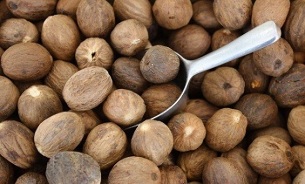
Folk remedies for varicose veins include recipes based on nutmeg. These fruits have gained popularity because they stimulate blood circulation. However, no more than one nutmeg should be consumed per day. This leads to poisoning of the body and the appearance of hallucinations. Nutmeg for varicose veins is used as follows:
- whole nuts are ground into powder;
- 1/3 teaspoon of the resulting product is poured with 250 ml of boiling water;
- After the mixture has cooled, add a tablespoon of honey.
Take this broth just before breakfast. It is advisable to prepare a new serving every day, otherwise the essential oils of the product will fade, which will negatively affect its effectiveness. Some healers recommend making a tincture of vodka with nutmeg. 200 g of nut powder are poured with 1 liter of vodka, let the mixture steep for 1 week. Take the medicine three times a day, 20 drops 30 minutes before meals.
Recipe No. 2 based on honey and propolis
Compresses for varicose veins made from honey are a common way to normalize the condition of blood vessels. The fabric is smeared with honey and then applied to the leg. A plastic wrap is wrapped over the compress. If you are concerned that such a design could slip somewhere, you can pull stockings or tights over them. Compresses are recommended before going to bed. You can make propolis tincture according to the following recipe:
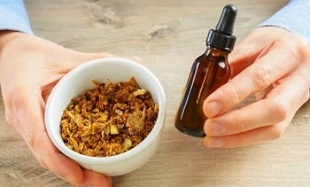
- 20 g of propolis are crushed and 30 g of gray jaundice, 0. 5 lemon together with peel are added;
- the resulting mixture is poured with 300 ml of vodka and insisted for 3 weeks;
- finished infusion is used to rub the legs for a month.
Apitherapy against varicose veins is indicated for people who do not suffer from bee sting allergies. If the patient reacts slightly to honey or propolis, then this method of treating varicose veins cannot be used. The procedure is performed by a doctor. He plants a certain number of bees in a biologically active area. After the bite, the sting remains in the patient's body for some time so that the poison completely penetrates the leg.
Recipe No. 3 made from green tomatoes
Unripe tomatoes are considered an excellent folk remedy for leg swelling with varicose veins. Doctors put forward the theory that an unripe vegetable contains an increased amount of lycopene, so compresses from this plant perfectly relieve pain and reduce swelling of the veins. The recipe itself is pretty simple. Green tomatoes are cut into large pieces and applied to the venous nodes. It is recommended to secure the vegetables with a bandage. Keep the required compress until there is a burning sensation. Healers recommend performing the procedure at night.
Ginger recipe No. 4
The benefits of this plant are legendary! It is used to improve digestion, reduce weight, get rid of migraines, and so on. To treat varicose veins on the legs with folk remedies, you need raw ginger root. Regular dry seasoning won't work.
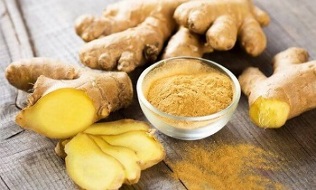
One of the most popular remedies for toning the body, improving blood circulation and relieving tiredness is a tea based on this spice.
Making tea is simple enough: you need to cut a small piece from the root of the plant, pour boiling water over it and let it steep for ten to fifteen minutes. It is worth taking this remedy at a comfortable temperature. Ginger for varicose veins not only helps cope with poor venous tone, but it also activates metabolism, so people who take such tea will gradually lose weight. A ginger compress is also effective for varicose veins. Prepare it like this:
- The root is rubbed very finely.
- The resulting porridge is mixed with honey.
- The mixture is applied to the inflamed veins for about three to four hours.
To increase the effect of the compresses, you can wrap cling film over it and then put on warm trousers or lie under the covers. The duration of treatment is one month.
Horse chestnut recipe No. 5
Treatment of varicose veins at home with folk remedies is rarely completed without the use of horse chestnut. A tincture is made from the fruits of the plant. The raw material is crushed to a pulp with a meat grinder, and then placed in a three-liter glass, which is half filled with vodka. The mixture is infused for a month. The ratio of chestnuts to vodka should be one to three. While the mixture is being infused several times a week, it is shaken and then returned to its place.
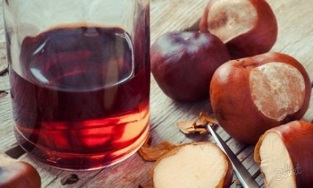
After a month, the veins damaged by varicose veins are wiped off with the finished tincture. Some healers recommend using the remedy internally, but before that you should consult your doctor as chestnuts are poisonous in themselves and can cause bleeding as they reduce blood clotting. The infusion can be given orally if you have a precisely high number of platelets in your blood.
Viburnum recipe No. 6
As with ginger, the berries of the plant can be used to make a fortified drink or for a compress. The viburnum compress for varicose veins is made in the usual way. The berries are ground to a state of pulp, then the mixture is spread on a bandage or cotton rag, and then applied to the affected area. It is necessary to keep such a composition for 8-9 hours, so it is recommended to do the compress before going to bed. The preparation of the drink is very simple. From viburnum berries, 500 ml of juice is obtained, and then 2 tablespoons of honey is added to the liquid. Allergy sufferers can do without the last ingredient. Drink 2 tablespoons of the drink 4 times a day.
Recipe No. 7 based on Mama
This special product is ideal for treating swellings and congestion. If you are not afraid of the unpleasant smell and the high price, you can make compresses for varicose veins from the mummy. They only help well in the early stages of the disease. Mumiyo is mixed with Vaseline in a ratio of 1 to 5. Mix the ingredients thoroughly until smooth. Rub the resulting ointment on the affected areas of the legs three times a day. Wash off 1-2 hours after application. Some recommend consuming a mixture of mummy, honey, and milk. It is made in a ratio of 1: 6: 6. Therapy lasts 1 month.
Recipe No. 8 from Adam's apple

Maclu fruits are inherently poisonous. You can't eat them like snake venom, but you can use them to make a homemade ointment. You will need lard, Adam's apples, and a glass water bath. The container is filled with molten lard fifteen millimeters, and then Adam's apple slices are placed in a ten-millimeter layer. The process is repeated until all the ingredients are used up. The last layer should be lard. After that, the container is slowly set on fire, the resulting mixture is heated, then filtered, cooled and used in place of the ointment twice a day. In a similar way, you can cook pumpkin for varicose veins.
Recipe No. 9 made from lemon
Lemon treatment for varicose veins can be done externally and internally. Unfortunately, regular tea made with this citrus in no way helps improve the tone of the veins, but pure lemon juice is a great way to prevent further vascular damage. You can make a lemon compress. To do this, cut the citrus fruits in circles and apply them to the affected areas. You need to wear such a compress all day, replacing the circles with new ones every 3-4 hours. The leg is of course wrapped in bandages for tight fixation.
Potato recipe No. 10
This folk remedy is the cheapest because these root vegetables can be bought in any greengrocer. Treatment of varicose veins on the legs in women with potatoes is carried out as follows:

- The root plant is washed and peeled and then rubbed on a medium grater.
- The resulting paste spreads over the area damaged by the disease.
- 8 layers of bandages or gauze are wrapped over the potatoes, and then everything is held in place with cling film.
The compress should be kept for about 4 hours. It is made from fresh potatoes. Potatoes are not suitable for this purpose.
Onion recipe no. 11
It is the onion skin that is effective for varicose veins, not the vegetables themselves. You can use them to strengthen your immune system, eat them raw or cook some dishes with them. Onion skins can be made in one of the following ways:
- 2 tablespoons of chopped onion peel pour 500 ml of boiling water. The mixture is infused for 6 hours and then filtered. Take 75 ml 3 times a day. The duration of treatment is 10 days.
- 2 tablespoons of chopped onion peel are poured into 100 ml of vodka. The mixture is infused in a cool, dark place for 7 days. The resulting tincture is taken 20 drops a day three times a day, 15 minutes before eating. The duration of treatment is 14 days.
Recipe No. 12 based on fish oil
Fish oil for varicose veins is most often taken orally. This product allows you to speed up the metabolism and get rid of fluid stagnation in the limbs.
If, for one reason or another, you do not like such a remedy, you can turn it into a compress. For this purpose, fish oil and honey are mixed in a ratio of 1 to 1. The resulting mixture is spread on a cotton cloth or gauze, and then the limb affected by varicose veins is bandaged with it. Healers recommend using may honey for the compress, but if you don't have it on hand, any other variety can be used.
Celery recipe No. 13

Treatment of leg veins with folk remedies is not always easy. Celery for varicose veins is contraindicated to eat, but it can be added to carrot juice along with spinach.
Drink the resulting drink immediately. The ratio of carrot juice to other ingredients is 7: 3: 3.
Garlic Recipe No. 14
Garlic against varicose veins is effective in the form of compresses. In this recipe, healers use the composition of this plant directly. It contains many essential oils that naturally irritate the vessel walls. Prepare a garlic compress for varicose veins as follows:
- Garlic is cut into pulp together with the peel.
- Add 1 to 2 butter to the finely chopped product.
- Mix the ingredients thoroughly.
- The resulting ointment is applied to the affected veins at bedtime and a bandage is wrapped on them. The duration of treatment is 1 month.
Recipe No. 15 based on wormwood
Among the folk remedies for varicose veins of the legs, those whose composition includes wormwood are considered effective in the second stage of the disease. This plant promotes blood thinning, so it is effective in the second stage of the disease. The plant also stimulates digestion, improves the outflow of bile from the liver, and improves overall metabolism. When used correctly, the plant contributes to the destruction of pathogenic microflora in the body. Wormwood for varicose veins can be used in several ways:
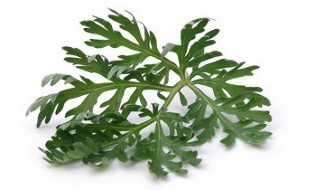
- The simplest recipe is to put 3 tablespoons of chopped herbs in a 500 ml glass and then pour vodka on top. You have to insist on the remedy for 14 days. After the tincture is ready, it is used to lubricate the damaged areas of the legs.
- Sour milk is taken from the plant for the compress. It is mixed with wormwood leaves and heads. The result should be a pulp. It is applied to the legs. The limbs are connected. It is recommended to do such a compress at night.
Despite the fact that wormwood is one of the most effective plants against varicose veins, it should not be used for thrombophlebitis.
Rose hip recipe No. 16
Folk recipes for varicose veins often include decoctions based on rose hip. Indeed, this plant is rich in vitamins. It contains magnesium, phosphorus, essential oils and other useful substances. But the rose hip with varicose veins alone does not force the body to regenerate. Rosehip tincture must be taken in small doses as it can cause blood clots and arrhythmias. Because of this, it is possible to treat varicose veins with this plant only with the official approval of a doctor. Doctors recommend rose hip treatment in the following cases:
- with severe mental or physical fatigue;
- with exacerbation of cholecystitis, to facilitate the outflow of bile;
- if the skin is very flaky due to a vitamin deficiency;
- if you have digestive problems.
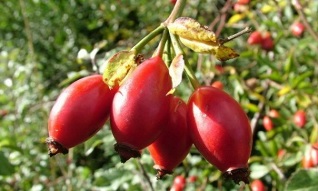
Tincture is not difficult to make. 15 g of plants are poured with 500 ml of boiling water and wait for the broth to cool.
Do not take this product on an empty stomach. It can only be taken after meals. It is advisable to take about 100 ml of broth three times a day. For colds, you can add raspberries to the rose hip. This broth activates the body's immune system.
Nettle recipe No. 17
Nettle for varicose veins helps get rid of the high platelet count. Treatment can be carried out both with the help of special decoctions, and other methods. Treating the affected areas with a nettle broom is considered particularly effective in treating varicose veins. Movements should be from the feet to the hips. The treated areas will itch for the first few hours, but then it will all pass. The benefit of this procedure is the activation of blood flow.
Herbal medicine for varicose veins also includes taking stinging nettle-based decoctions. 2 tablespoons of dry leaves of the plant need to be crushed, and then put in a thermos, pouring 2 cups of boiling water. The product should be infused for 3-4 hours. After the infusion is ready, it is consumed three times a day at 1/3 of the total volume. If the liquid runs out, you need to cook more.
Recipe No. 18 based on aloe
With the help of aloe, varicose veins can only be treated in the early stages. The plant promotes tissue regeneration, but in and of itself it is not necessary to help with the disease. It is recommended to combine it with drug therapy. Aloe for varicose veins can be used in the following ways:

- Rub the feet with aloe juice. This helps relieve muscle spasms and reduce leg swelling.
- Mix 100 grams of aloe juice with 5 grams of mummy. The legs are lubricated twice a day for 28 days. This remedy also promotes healing of minor skin injuries, but should not be used on trophic ulcers.
- Mix the Kalanchoe and Aloe juice in equal proportions, then add 30 ml of vodka. Stir the mixture thoroughly, then rub it into your feet.
- Mix equal parts of aloe juice, sea buckthorn and olive oil, then rub the resulting mixture on the legs twice a day for 1. 5 months.
Recipe No. 19 based on the golden mustache
Collision is known as a universal remedy for various diseases. The effectiveness of the plant in treating various diseases is very easy to explain. It has a rich composition. Using golden whiskers for varicose veins along with other herbs has a stronger effect than using a single herb. To improve blood circulation, it is recommended to use the following folk remedy for varicose veins:
- 3-4 finely cut leaves of a golden mustache are mixed with 2 glasses of honey;
- add the juice of 6 lemons and 5 crushed cloves of garlic to the mixture;
- The components are mixed thoroughly, placed in a glass container and infused for 7 days.
The resulting mixture is taken in 2 teaspoons twice a day for a month. This composition will help get rid of complications with varicose veins and reduce severe edema.
Lilac recipe no. 20
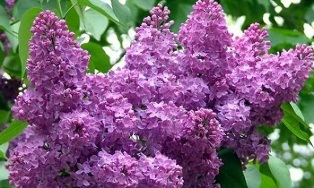
Lilac tincture for varicose veins is made from leaves according to the standard scheme, that is, they fill half a 500 ml glass with it and add vodka there. The mixture is infused for a week and then the limbs are coated with the resulting drug. It is allowed to use the flowers of this plant instead of leaves. Traditional healers recommend using lilac bark in the fight against venous knots. It is applied to the affected area and fixed with a bandage from above. You need to wear such a compress all day.
Recipe No. 21 based on flaxseed
Use flaxseed for varicose veins if severe swelling is observed. This product helps get rid of excess fluids. Folk healers recommend using a linseed brew every 2 hours. Prepare it like this:
- put 500 ml of water on fire and bring to a boil;
- add 4 tablespoons of flaxseed;
- The mixture is boiled for 15 minutes and then cooled and, if necessary, filtered.
Take the resulting broth should be 4 tablespoons every 2 hours until the swelling subsides. Be sure to read the contraindications for use before using the product. They are on the seed package.
Mud recipe No. 22
Doctors are not sure whether varicose veins should be treated with mud. Some experts say these procedures improve blood circulation, help the body get rid of toxins, while others claim they can cause harm.

The mud treatment for varicose veins should be cold. Peloid therapy is carried out at home using body wraps. You will need:
- wooden bowl and spoon (metal cannot be used);
- cling film;
- dirt (available at a pharmacy or beauty salon);
- various additives.
In some cases, clay can be added to the mud. These components work well together. The mixture is diluted with water to sour cream at room temperature, and then applied to the areas affected by varicose veins. This composition is kept on the skin for 1-2 hours. If you feel dry or tense, rinse off the dirt, check your body for allergies, and apply a moisturizer.
Recipe No. 23 made from carrots
Carrot tops for varicose veins have been used for 30 years. The top of the plant can be obtained by any summer resident. Before preparing the tincture from this part of the vegetable, it is necessary to scald the leaves with boiling water. This manipulation relieves the plant of the bitter taste. A remedy for the treatment of varicose veins can be made according to one of the following recipes:
- For the broth, 10 tablespoons of finely chopped tips are mixed with 2 liters of water. The resulting mixture is heated over low heat, filtered, and then taken in 20 ml three times a day. The duration of treatment is 14 days.
- A tablespoon of dry raw materials is poured with 500 ml of boiled water, infused for 1 hour, and then consumed in 100 ml three times a day.
- A more concentrated infusion is made in a thermos. Pour 1 tablespoon of herbs with a glass of boiling water, then let it steep for 30 minutes. After the infusion cools, drink everything. Take up to 5 servings of this product per day.
Clay recipe No. 24

This fine-grain sedimentary rock is used in various cosmetic procedures. It is best used to treat vascular diseases, blue tone. It perfectly penetrates skin barriers and contains a lot of useful trace elements. The most popular is the following clay recipe:
- 200-300 g of dry raw materials are diluted with water to the consistency of thick sour cream;
- The resulting mixture is placed on areas where there are swollen veins (layer thickness - 2 cm).
- a terry towel is placed on the leather with clay;
- , if you want, you can fix the application with cling film.
Keep the resulting product on your feet for at least 2 hours. Folk healers recommend applying every day. The duration of treatment is 1, 5 months. After the feet improve, the thick clay mixture can be replaced with a terry towel soaked in clay solution.
Remember, clay is not for everyone. If you have sensitive skin, replace the blue tone with red or pink if it's dry or irritated. If acne occurs, the product must be discarded.
Recipe No. 25 made from hydrogen peroxide
This folk technique is considered to be a little harmful to health and especially for the pancreas. Medical advice is therefore required. Hydrogen peroxide from varicose veins is used in two ways. The first is to take the drug orally. 1 drop of peroxide is diluted in 3 tablespoons of water and consumed 2 hours after a meal. Every day the concentration of the substance is increased by 1 drop, which makes 10 drops. After that, take a 72 hour break and start using 10 drops every 2 days. Take a 3-day break between doses.
The second method is more invasive. The patient prepares a 0. 015% hydrogen peroxide solution and then injects it intravenously dropwise. If you have no experience of such manipulations, then it is better not to do it. This introduction of hydrogen promotes the release of atomic oxygen. The walls of the blood vessels are cleaned so that the edema goes away. The maximum administered dose of the substance is 250 ml.
Duration and rules of treatment with folk remedies
One of the main factors that will affect the effectiveness of alternative treatment is the stage of the disease. With a slight stretching of the vessels, they relieve swelling, improve the condition of the skin and restore the tone of the veins. Knowing what is afraid of varicose veins can prevent their further development, but you should not stop treatment completely after the symptoms of the disease have gone. You need to repeat the procedures every 3-4 months using the folk remedies that are suitable for you to avoid relapse. Treatment rules:
- Mix the ingredients in the ratio recommended in the recipes.
- In the event of burns, itching or other incomprehensible reactions, stop using the product.
- Use the finished product for the entire recommended treatment period and only when there are first improvements.
- Store in a cool place to avoid premature deterioration.
Combination with conventional treatment methods
Traditional medicine can only be introduced into drug therapy with the approval of a phlebologist. Remember that there should be at least 2 hours between using tinctures and different tablets. When using folk remedies, it should be clearly understood that they cannot replace medication, although some healers claim that it does not. In addition, some homemade drugs can pose a life risk, which is why treatment using such methods must be carried out very carefully.
Possible risks and contraindications
Folk remedies are not a panacea. They themselves can cause allergies and other negative reactions in the body. The use of traditional medicine is contraindicated in the following diseases:
- Diseases of the stomach and intestines;
- problems with blood clotting;
- liver and kidney diseases;
- advanced stage of varicose veins, accompanied by venous thrombosis.
Patients must discuss any treatment with a doctor. It is not recommended to independently prescribe traditional medicine without examining the body.




































